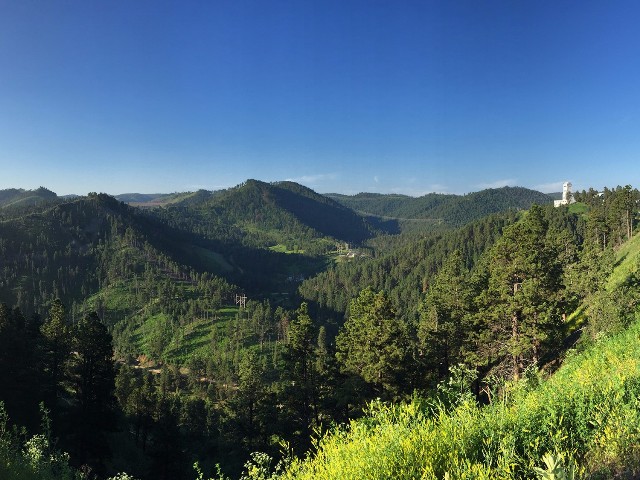Aug 4 2015
The Black Hills region in western South Dakota is known for its rich stores of gold and silver. In fact, 41 million ounces of gold and 9 million ounces of silver were pulled from Homestake Mine in Lead, SD between the 1870s and early 2000s. During that time, 370 miles of mine tunnels were created, reaching depths of 8,000 feet.
But in 2006 science took over: Sanford Underground Research Facility (Sanford Lab) is an underground particle physics research complex housed in the former mine, using the earth and rock to shield experiments from cosmic rays. The better the shielding, the more likely the scientists will detect neutrinos and suspected dark matter particles called WIMPs. Earlier this summer, Lead celebrated the ribbon-cutting of a new visitor center that highlights the history of the old mine and the current and future science at Sanford Lab.
 The view from Homestake. There are two main entrances to the mine, the Ross and Yates shafts. The Ross shaft, in the distance, is under refurbishment so scientists and construction workers use the Yates Shaft to access Sanford Lab.
The view from Homestake. There are two main entrances to the mine, the Ross and Yates shafts. The Ross shaft, in the distance, is under refurbishment so scientists and construction workers use the Yates Shaft to access Sanford Lab.
The U.S. Department of Energy’s Lawrence Berkeley National Lab (Berkeley Lab) is a key player in the creation of Sanford Lab and in the operation of some of its current and future experiments, including the dark matter experiment called LUX and a neutrino experiment called the MAJORANA DEMONSTRATOR. Berkeley Lab is also managing the Berkeley Low Background Facility and the forthcoming LUX-ZEPLIN (LZ) dark matter project, which builds on the accomplishments of LUX.
As a science writer for Berkeley Lab, I was able to catch a ride on one of the mine’s elevators, called a cage, and descend 4,850 feet down to learn more about the science and the scientists who work on these projects.
Notes from the Particle Physics Underground—Descending Nearly a Mile Underground
It takes about ten minutes to ride the cage down to the 4,850 level where LUX and the MAJORANA DEMONSTRATOR are located. This video captures the last few seconds of the cage ride and the entry into the Davis Campus.
The above slideshow illustrates what it’s like to go underground. The short video below shows the last few seconds of the cage ride and our exit into the space called the Davis Campus, completed in 2012 and home to the MAJORANA DEMONSTRATOR, the LUX experiment, and other facilities.
In addition to checking out the MAJORANA DEMONSTRATOR and LUX projects, I joined a tour given to a group of esteemed scientists (including Berkeley Lab’s Eric Linder) who were in the nearby town of Deadwood, SD for a conference on particle physics and cosmology. As part of the tour, we traveled through unlit tunnels, visited construction sites of a future experiment, and walked through the refuge chamber, a shelter equipped with water, meal bars, and canisters of breathable air in case a fire or other disaster strikes.
I went underground at 7:30 a.m. and came back up at noon. My four and a half hours of being shielded from daylight and cosmic rays was pleasant enough, but when I stepped outside, above ground, I was glad to see a bright sun and feel the breeze on my skin.
Below is a slideshow that details the underground experiments. The short video that follows gives a sense of what it’s like to travel through the tunnels.
All photo and video credits: Kate Greene.